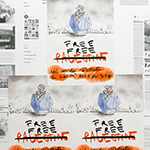Laveronica Arte Contemporanea is pleased to announce the opening of CENSORED, an exhibition on regimes of visibility and power. CENSORED, curated by Marco Scotini, aims to provide visibility to all those works that have been removed from exhibition contexts for political reasons or give voice to those art projects that have been pre-emptively withdrawn from public display. The exhibition is less about censorship in general and more specifically about state political censorship.
The so-called Western democracies barely had time to digest the thesis of The Age of Surveillance Capitalism when the covid pandemic gave them the chance to see just how far state authoritarianism had come since the 2008 financial crisis. Perhaps, it was already too late for them to realise that the control-come-business of digital platforms was no longer the only challenge facing today’s democracies. The new alliance between market liberalism and nationalist authoritarianism is now the driving force behind the forms of power we face. Even censorship, which we believed to be a remnant of totalitarianism (blocks to social media, limits on access to information), has reappeared – not only as a form of control but also as a tool with which to silence all forms of opposition to the powers-that-be. And always hand in glove with the unfettered movement of free market forces.
But is this simply a return of the kind of censorship that reached its peak in the twentieth century? Or is a new configuration of power and its scope for perpetuating it now in play? A form of censorship expressed via algorithms and digital sovereignty is at work today, along with the more traditional forms of intelligence agencies and judicial forces, expressing the two-fold nature of contemporary capitalism: violence and institution, liberality and censorship, governmentality and war, hypermodernity and neoarchaism. Public censorship and repression have only intensified with the rise of the ideology of the new European right. The fact that these measures pass in the form of ethnic (anti-Semitism and Islamophobia) and racial (vandalism and transphobic intolerance) motivations rather than class-based ‘legitimations’ should not however make us lose sight of the original matrix behind all this: something that lies at the heart of the radical asymmetries of contemporary capitalism.
With the coverage and subsequent removal of the work of the Indonesian art collective Taring Padi at the last Kassel documenta, what was already in place with the motion against the BDS movement deployed by the German Bundestag in May 2019 ends up in the public eye and appears to be at the origin of alarming censorship and a repressive escalation in the name of a “philosemitic McCarthyism” that did not need to wait for Hamas’s October 2023 attack on Israel to embark on its crusade. A wave of state-imposed bans, deletions, censorship, defamation and discrimination has never ceased to repeatedly hit artists, intellectuals, journalists and the civilian population, from then up until the final resolution against anti-Semitism ‘Never Again Is Now’ a month ago. But as early as November 2023, even the entire selection committee of Documenta had resigned because of the restrictive limitations that have been forced onto German culture. Yet while the situation in Germany has become intolerable, the rest of the world (including Italy) is no less repressed and controlled.
In this sense, the CENSORED exhibition sets out to oppose these conditions by trying to bring together a number of cases of major international artists whose works – at different latitudes and at different times – have undergone the same treatment and have been withdrawn from exhibition or excluded from circulation. One need only cite the well-known and recognised examples of Candice Breitz (whose exhibition and lecture in Germany were cancelled) and Daniela Ortiz whose works at the Bundeskunsthalle in Bonn were required to be examined and evaluated by anti-Semitism experts. Until recently, contemporary liberalism was said to employ a practice through which dissonant voices were no longer addressed but rather reabsorbed, integrated and neutralised. This is no longer sustainable in the face of so many cases of violent censorship that challenge the very notion of democratic culture day in day out.
Despite everything, independent forces are organising everywhere against the various attempts at cultural domination (be it in of gender, race or class) to claim the necessary plurality of viewpoints as well as freedom of expression and action. The CENSORED exhibition joins these antagonistic forces by presenting itself as a judicial repository in which various types of works (drawing, film, performance, neon signs and architecture) are stored, each documenting time, place and reasons for the censorship inflicted upon it: inviting the public to take a stand in assessing the events taking place. It is no coincidence the Galleria Laveronica finds itself promoting such an exhibition, since on various occasions, many of its artists have been affected by such coercive treatment.
Aware that – unless the economic conditions of contemporary capitalism change – everything will be destined to degenerate further and rapidly too, the CENSORED exhibition shuns any naïve or (falsely) moralistic discourse designed to promote antagonistic political-economic programmes beyond that of denunciation. There are no corrective measures to be made to the system: the only option is to overturn the current power structure. Otherwise, from now on, our only choice will be to write on the façades of our cultural institutions (museums, biennials, galleries and bookstores, etc.): PRODAJEM AUTOCENZURU (Self-censorship on sale), as the dear Mladen Stilinovic so caustically did.
Artists: Nanni Balestrini and Luigi Nono, Candice Breitz, Claire Fontaine, Rolando Certa (Antigruppo Siciliano), Dora García, Igor Grubić, Marcelo Expósito, Grup Etcetera, Adelita Husni Bey, Emily Jacir, Maryam Jafri, Rabih Mroué, Ahmet Ögüt, Daniela Ortiz, Paloma Polo, Oliver Ressler, Renato Spagnoli, Jonas Staal.
The exhibition was made possible thanks to the contribution of: Gallery Apart, Galleria Gian Marco Casini, Galleria Michela Rizzo, Galleria Simóndi, REPLICA (Lisa Andreani and Simona Squadrito)
Press release from Laveronica Arte Contemporanea
Image: Installation view of CENSORED. An ongoing archive of silenced voices, Laveronica, Modica, 2024. Image courtesy of the artist



